Paper Menu >>
Journal Menu >>
 Energy and Power Engineering, 2013, 5, 842-849 doi:10.4236/epe.2013.54B162 Published Online July 2013 (http://www.scirp.org/journal/epe) A High Power Factor Rectifier Based on Buck Converter Operating in Discontinuous Inductor Current Mode* Jianbo Yang1, Weiping Zhang2,Faris Al-Naemi1,Xiaoping Chen2 1Materials and Engineering Research Institute (MERI), Sheffield Hallam University (SHU), Sheffield, UK 2Lab of Green Power & Energy System (GPES), North China University of Technology (NCUT), Beijing, China Email: jumbo-yang@hotmail.com Received September, 2012 ABSTRACT By adding a suitable LC filter to the input of a Buck converter, a high-power-factor buck converter is proposed. The converter can operate in the discontinuous-output-current mode operation. A Buck converter in this operation mode features simple control as the constant duty cycle PWM used. The operation condition of the converter is studied. The validity of analysis is verified by Simulation and Experimental results. Keywords: Discontinuous-output-current; Buck Converter; Power Factor Correction 1. Introduction Intensive research has been carried out to improve the power factor of AC/DC converters [1]-[4]. Among the research, it has been reported that by adding a suitable LC filter to the input of a Buck converter to make the converter operate as power factor correction circuit [5] [6]. An example of the converter is presented in Fig. 1. The input capacitor C1 usually has a low enough value and the voltage across it can be discontinuous. Then a high-power-factor can be obtained by a simple constant duty ratio PWM control. However, the voltage stress across switch(S in Figure 1) and diode (D in Figure 1) imposes major restrictions as the peak value of Vc1 is very high when Vc1 becomes zero for part of the switch- ing cycle. In this paper, the Buck converter with LC in- put filter operates in a “discontinuous-output-current” mode. The current of output inductor (L2 in Figure 1) fells to zero for part of the switching cycle and the volt- age of the input capacitor (C1) becomes continuous. Thus, the peak value of Vc1 is reduced substantially and switch voltage stress will be no longer a restriction. Besides the reverse recovery loss of the freewheeling diode (D) is reduced. The goal of this paper is to give a more comprehensive analysis of Buck converter with the LC input filter oper- ating in DICM. In section 2 of this paper, the principle of DICM is analyzed. Based on the analysis, the character- istics of the converter and the conditions for power factor correction are studied in section 3. In section 4, the sim- ulation and experimental verifications are given. 2. Operation Principles of DICM 2.1. Operation with Constant Input As shown in Figure 1, if C1 has large enough value, it will operate in CCVM and the voltage across C1can be considered constant during one switching cycle. L1 has large value so that the input current i I can be consid- ered as constant. Inductor L2 has low enough value and operates in DICM. With these assumptions, the converter is the same as the Buck DC/DC converter operating in DCM and the characteristic waveform are presented in Figure 2. The operation over one switch cycle is as fol- lows: 1) 0 < t < DTs: at t = 0, S is turned on. The current through C1 is io I I . L2 is charging under constant voltage (io VV ).The current through L2 increases line- arly from zero. Accordingly, the current through C1 de- creases linearly. When 2i I I 2i , 1c is positive, C1 is charging. And when i I I is turned to negative, C1 is discharging. 1c i *Project supported by Natural Science foundation of China (N0. 51277004). The Importation and Development of High-Caliber Talents Project of Beijing Municipal Institutions (No.IDHT20130501) Figure 1. Buck AC/DC converter with LC input filter. Copyright © 2013 SciRes. EPE 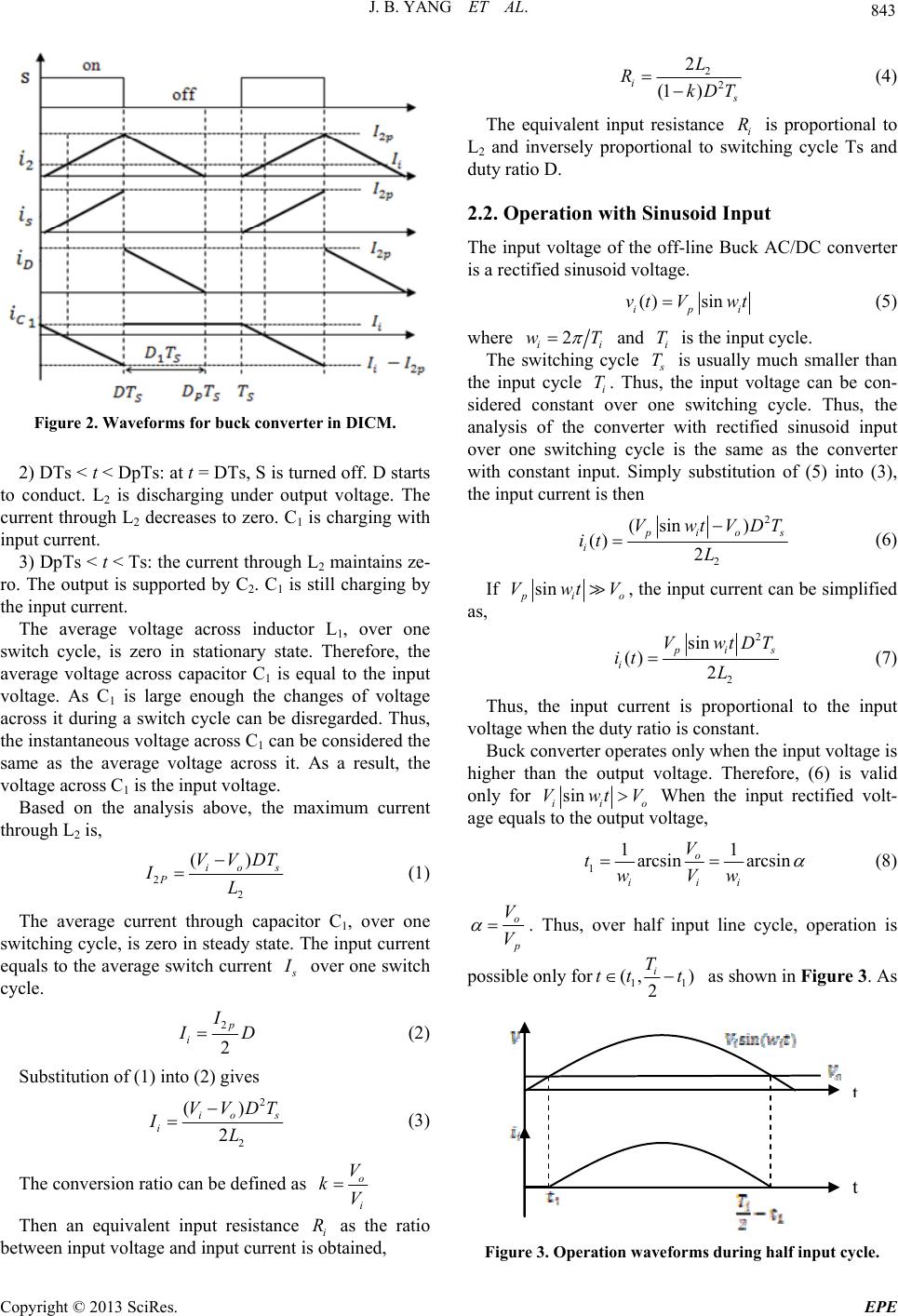 J. B. YANG ET AL. 843 Figure 2. Waveforms for buck converter in DICM. 2) DTs < t < DpTs: at t = DTs, S is turned off. D starts to conduct. L2 is discharging under output voltage. The current through L2 decreases to zero. C1 is charging with input current. 3) DpTs < t < Ts: the current through L2 maintains ze- ro. The output is supported by C2. C1 is still charging by the input current. The average voltage across inductor L1, over one switch cycle, is zero in stationary state. Therefore, the average voltage across capacitor C1 is equal to the input voltage. As C1 is large enough the changes of voltage across it during a switch cycle can be disregarded. Thus, the instantaneous voltage across C1 can be considered the same as the average voltage across it. As a result, the voltage across C1 is the input voltage. Based on the analysis above, the maximum current through L2 is, 2 2 () io s P VVDT IL (1) The average current through capacitor C1, over one switching cycle, is zero in steady state. The input current equals to the average switch current s I over one switch cycle. 2 2 p i I I D (2) Substitution of (1) into (2) gives 2 2 () 2 io s i VVDT IL (3) The conversion ratio can be defined as o i V kV Then an equivalent input resistance i as the ratio between input voltage and input current is obtained, R 2 2 2 (1 ) i s L RkDT (4) The equivalent input resistance i is proportional to L2 and inversely proportional to switching cycle Ts and duty ratio D. R 2.2. Operation with Sinusoid Input The input voltage of the off-line Buck AC/DC converter is a rectified sinusoid voltage. () sin ip vt Vwti (5) where 2 ii wT and is the input cycle. i T The switching cycle s T is usually much smaller than the input cycle i. Thus, the input voltage can be con- sidered constant over one switching cycle. Thus, the analysis of the converter with rectified sinusoid input over one switching cycle is the same as the converter with constant input. Simply substitution of (5) into (3), the input current is then T 2 2 (sin ) () 2 p io i VwtVDT it L s (6) If sin p i VwtVo , the input current can be simplified as, 2 2 sin () 2 p i i VwtDT it L s (7) Thus, the input current is proportional to the input voltage when the duty ratio is constant. Buck converter operates only when the input voltage is higher than the output voltage. Therefore, (6) is valid only for sin ii tVo Vw When the input rectified volt- age equals to the output voltage, 1 11 arcsin arcsin o iii V twVw (8) o p V V . Thus, over half input line cycle, operation is possible only for1 (, ) 2 i T tt t 1 as shown in Figure 3. As t t Figure 3. Operation waveforms during half input cycle. Copyright © 2013 SciRes. EPE 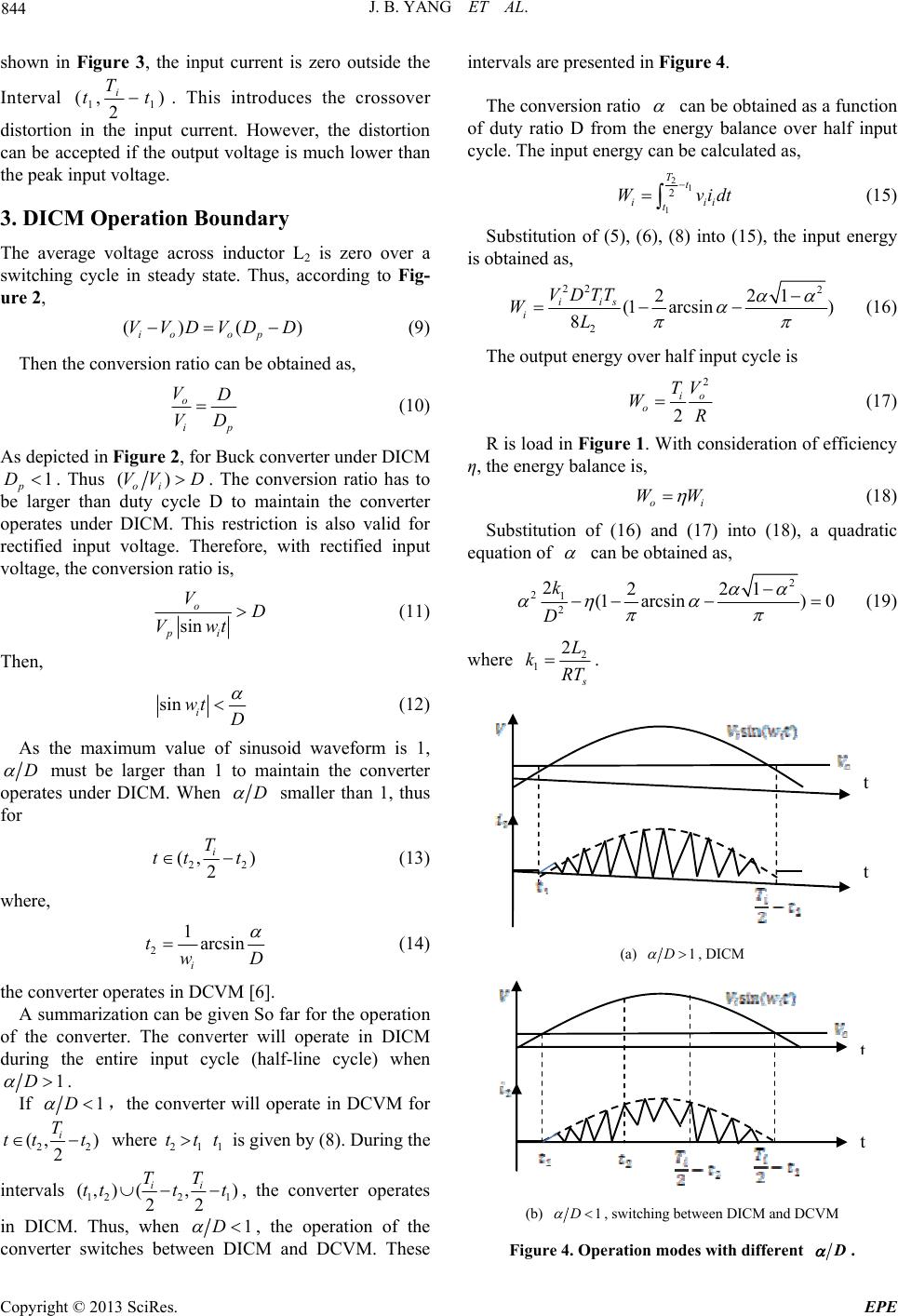 J. B. YANG ET AL. 844 shown in Figure 3, the input current is zero outside the Interval 1 (, ) 2 i T tt1 ) . This introduces the crossover distortion in the input current. However, the distortion can be accepted if the output voltage is much lower than the peak input voltage. 3. DICM Operation Boundary The average voltage across inductor L2 is zero over a switching cycle in steady state. Thus, according to Fig- ure 2, () ( io op VVDVDD (9) Then the conversion ratio can be obtained as, o ip VD VD (10) As depicted in Figure 2, for Buck converter under DICM . Thus 1 p D() oi VV D. The conversion ratio has to be larger than duty cycle D to maintain the converter operates under DICM. This restriction is also valid for rectified input voltage. Therefore, with rectified input voltage, the conversion ratio is, sin o pi VD Vwt (11) Then, sin i wt D (12) As the maximum value of sinusoid waveform is 1, D must be larger than 1 to maintain the converter operates under DICM. When D smaller than 1, thus for 2 (, ) 2 i T tt t 2 (13) where, 2 1arcsin i twD (14) the converter operates in DCVM [6]. A summarization can be given So far for the operation of the converter. The converter will operate in DICM during the entire input cycle (half-line cycle) when 1D . If 1D ,the converter will operate in DCVM for 22 21 tt1 t (, ) 2 i T tt t where is given by (8). During the intervals 12 (,tte converter operates in DICM. Thus, when 2 , 22 ii TT t 1 ) () , t th 1D , the operation of the converter switches betweenM and DCVM. These intervals are presented in Figure 4. DIC The conversion ratio can be obtained as a function of duty ratio D from the energy balance over half input cycle. The input energy can be calculated as, 21 Tt 1 2 ii i t Wvidt (15) Substitution of (5), (6), (8) into (15), the input energy is obtained as, 2 VD 22 2 221 (1 arcsin) 8 iis i TT WL (16) The output energy over half input cycle is 2 TV 2 io o WR (17) R is load in Figure 1. With consideration of efficiency η, the energy balance is, oi WW (18) Substitution of (16) and (1 eq 7) into (18), a quadratic uation of can be obtained as, 2 21 2 2221 (1arcsin) 0 k D (19) where 2 1 2 s L kRT . t t 1D , DICM (a) t t (b) 1D , switching between DICM and DCVM Figure 4. Operation modes with different D . Copyright © 2013 SciRes. EPE 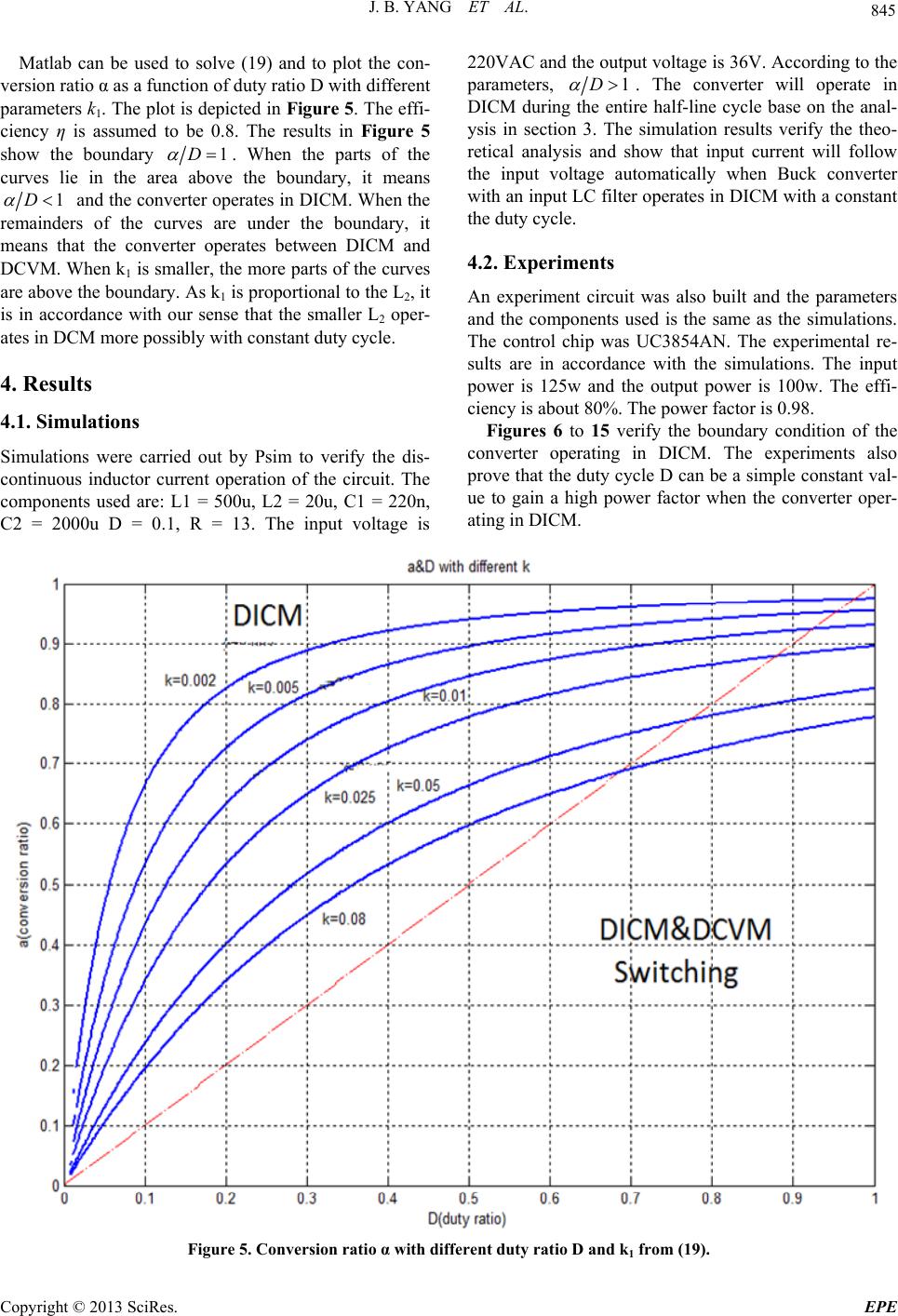 J. B. YANG ET AL. Copyright © 2013 SciRes. EPE 845 Maot thcon- ve 220VAC and the output voltage is 36V. According to the parameters, 1D . The converter will operate in DICM during the entire half-line cycle base on the anal- ysis in section 3. The simulation results verify the theo- retical analysis and show that input current will follow the input voltage automatically when Buck converter with an input LC filter operates in DICM with a constant the duty cycle. tlab can be used to solve (19) and to ple rsion ratio α as a function of duty ratio D with different parameters k1. The plot is depicted in Figure 5. The effi- ciency η is assumed to be 0.8. The results in Figure 5 show the boundary 1D . When the parts of the curves lie in the are the boundary, it means a above 1D and the converter operates in DICM. When the ers of the curves are under the boundary, it means that the converter operates between DICM and DCVM. When k1 is smaller, the more parts of the curves are above the boundary. As k1 is proportional to the L2, it is in accordance with our sense that the smaller L2 oper- ates in DCM more possibly with constant duty cycle. remaind 4. Results ions rried out by Psim to verify the dis- 4.2. Experiments An experiment circuit was also built and the parameters and the components used is the same as the simulations. The control chip was UC3854AN. The experimental re- sults are in accordance with the simulations. The input power is 125w and the output power is 100w. The effi- ciency is about 80%. The power factor is 0.98. 4.1. SimulatFigures 6 to 15 verify the boundary condition of the converter operating in DICM. The experiments also prove that the duty cycle D can be a simple constant val- ue to gain a high power factor when the converter oper- ating in DICM. Simulations were ca continuous inductor current operation of the circuit. The components used are: L1 = 500u, L2 = 20u, C1 = 220n, C2 = 2000u D = 0.1, R = 13. The input voltage is Figure 5. Conversion ratio α with different duty ratio D and k1 from (19). 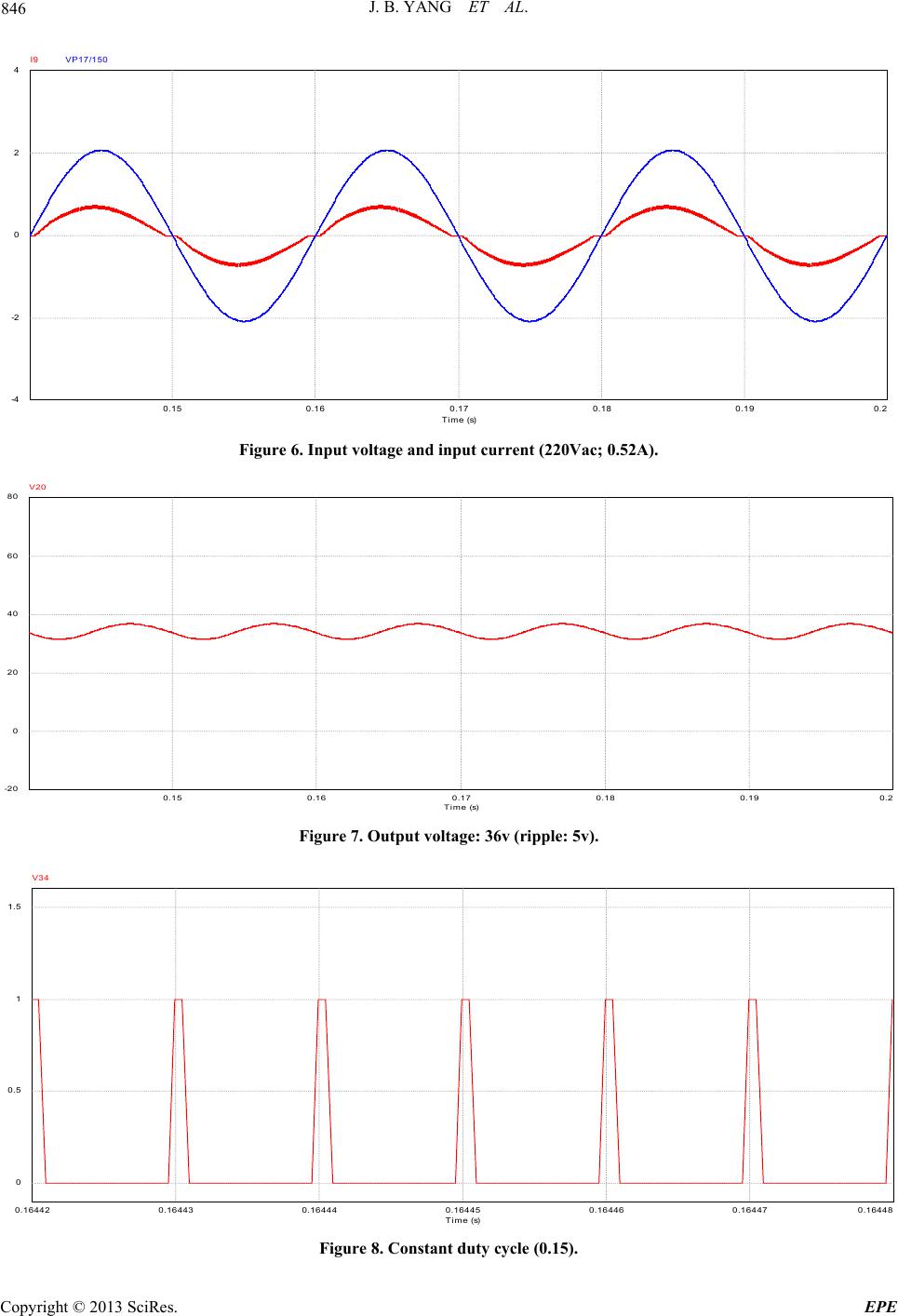 J. B. YANG ET AL. 846 0.15 0.160.17 0.18 0.190.2 Time (s) 0 -2 -4 2 4I9 VP17/150 Figure 6. Input voltage and input current (220Vac; 0.52A). 0.15 0.160.17 0.18 0.190.2 Time (s) 0 -2 0 20 40 60 80 V20 Figure 7. Output voltage: 36v (ripple: 5v). 0.16442 0.16443 0.16444 0.16445 0.16446 0.164470.16448 Time (s) 0 0.5 1 1.5 V34 Figure 8. Constant duty cycle (0.15). Copyright © 2013 SciRes. EPE  J. B. YANG ET AL. 847 0.16442 0.16443 0.16444 0.16445 0.16446 0.164470.16448 Time (s) 0 5 10 15 I(L15) Figure 9. Output inductor current (L2 in Figure 1: DCM). 0.150.160.170.18 Time (s) 0 50 100 150 200 250 300 350 VP18 Figure 10. Input capacitor voltage (C1 in Figure 1: CCM). Figure 11. Input Voltage: 220vac Input Current: 0.54mA). Copyright © 2013 SciRes. EPE 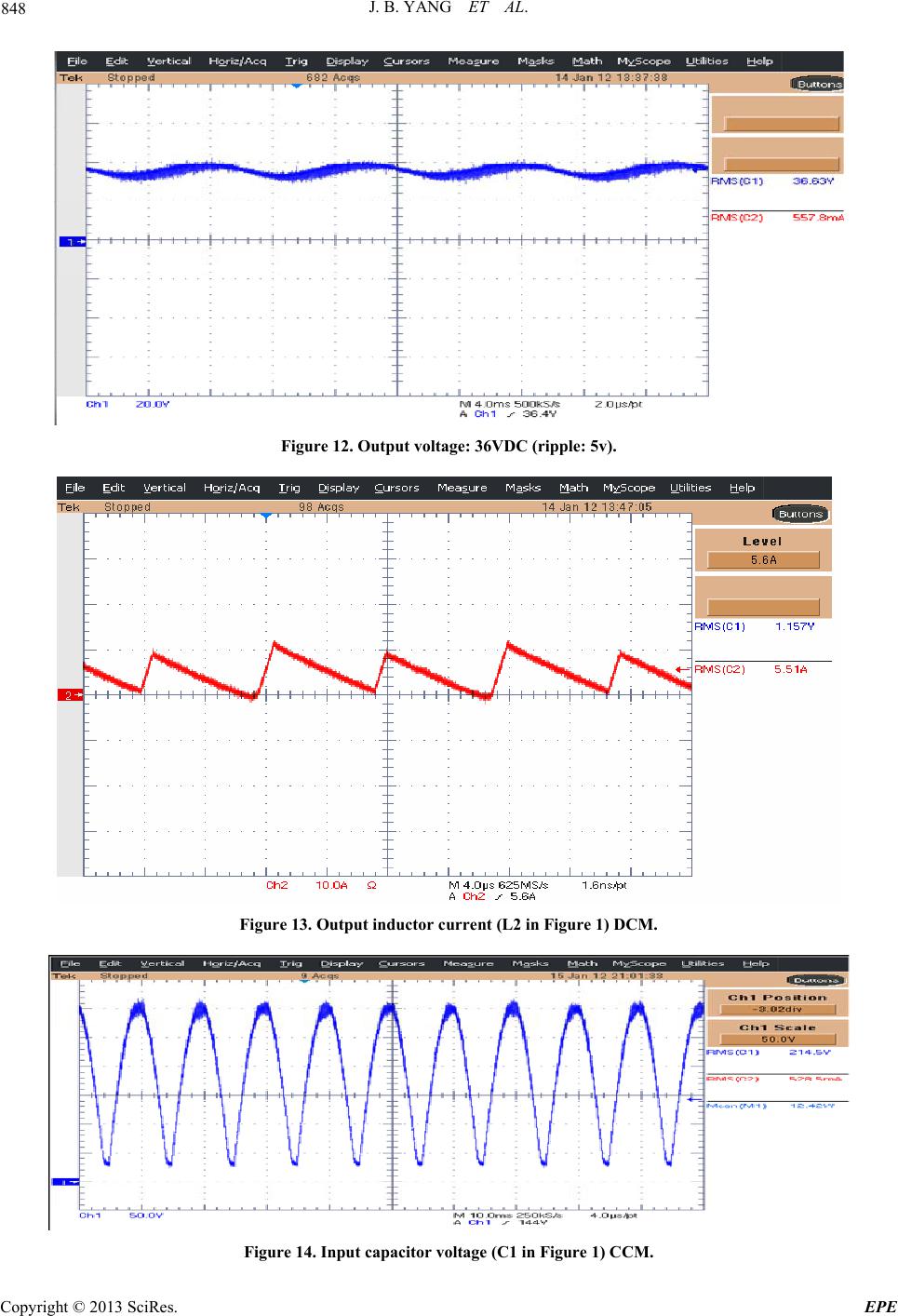 J. B. YANG ET AL. 848 Figure 12. Output voltage: 36VDC (ripple: 5v). Figure 13. Output inductor current (L2 in Figure 1) DCM. Figure 14. Input capacitor voltage (C1 in Figure 1) CCM. Copyright © 2013 SciRes. EPE 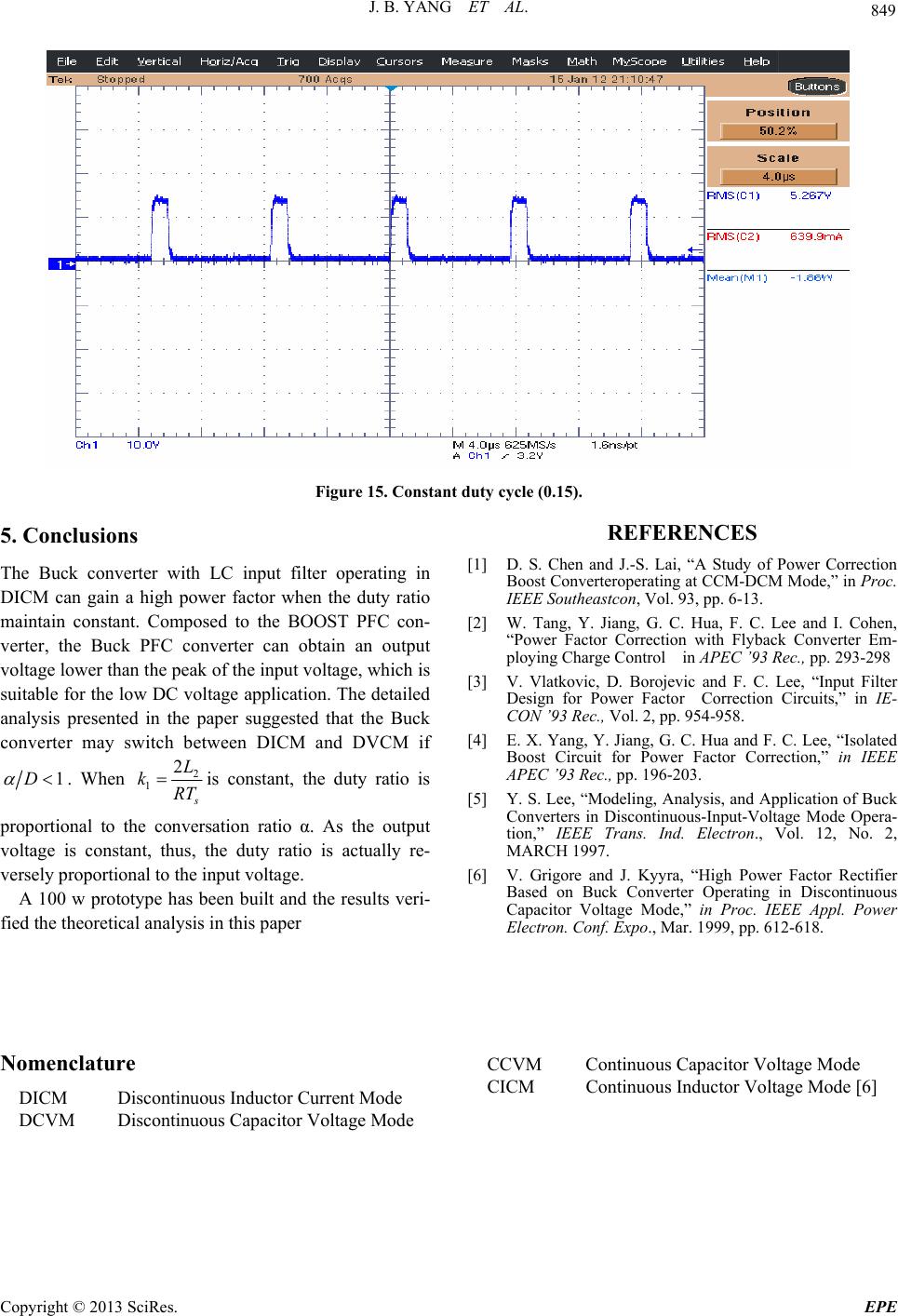 J. B. YANG ET AL. Copyright © 2013 SciRes. EPE 849 Figure 15. Constant duty cycle (0.15). 5. Conclusions The Buck converter with LC input filter operating in DICM can gain a high power factor when the duty ratio maintain constant. Composed to the BOOST PFC con- verter, the Buck PFC converter can obtain an output voltage lower than the peak of the input voltage, which is suitable for the low DC voltage application. The detailed analysis presented in the paper suggested that the Buck converter may switch between DICM and DVCM if . When 2 1 2 s L kRT 1D is constant, the duty ratio is proportional to the conversatio voltage is constant, thus, the duty ratio is actually re- versely proportional to the input voltage. A 100 w prototype has been built and the results veri- fied the theoretical analysis in this paper REFERENCES [1] D. S. Chen and J.-S. Lai, “A Study of Power Correction Boost Converteroperating at CCM-DCM Mode,” in Proc. IEEE Southeastcon, Vol. 93, pp. 6-13. [2] W. Tang, Y. Jiang, G. C. Hua, F. C. Lee and I. Cohen, “Power Factor Correction with Flyback Converter Em- ploying Charge Control in APEC ’93 Rec., pp. 293-298 [3] V. Vlatkovic, D. Borojevic and F. C. Lee, “Input Filter Design for Power Factor Correction Circuits,” in IE- CON ’93 Rec., Vol. 2, pp. 954-958. [4] E. X. Yang, Y. Jiang, G. C. Hua and F. C. Lee, “Isolated Boost Circuit for Power Factor Correction,” in IEEE APEC ’93 Rec., pp. 196-203. [5] Y. S. Lee, “Modeling, Analysis, and Application of Buck uous-Input-Voltage Mode Opera- nd. Electron., Vol. 12, No. 2, MARCH 1997. [6] V. Grigore and J. Kyyra, “High Power Factor Rectifier Based on Buck Converter Operating in Discontinuous Capacitor Voltage Mode,” in Proc. IEEE Appl. Power Electron. Conf. Expo., Mar. 1999, pp. 612-618. Nomenclature DICM Discontinuous Inductor Current Mode DCVM Discontinuous Capacitor Voltage Mode CCVM Continuous Capacitor Voltage Mode CICM Continuous Inductor Voltage Mode [6] n ratio α. As the output Converters in Discontin tion,” IEEE Trans. I |

